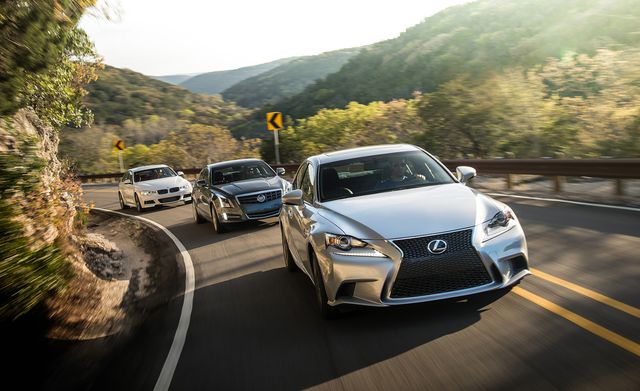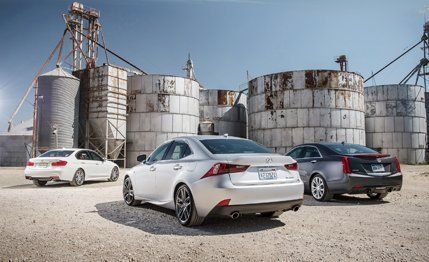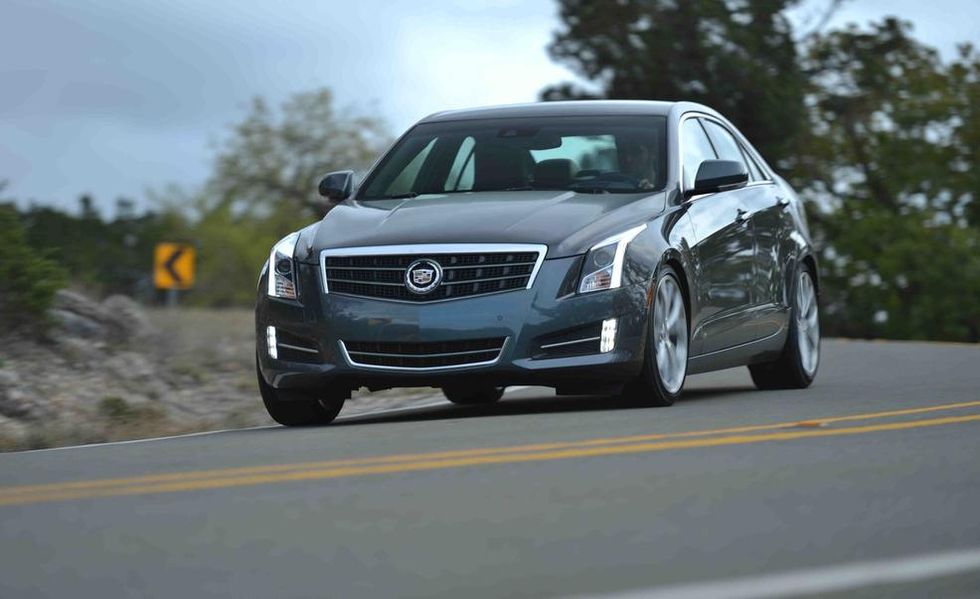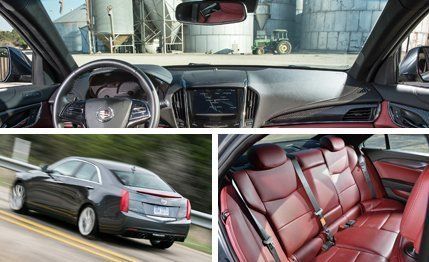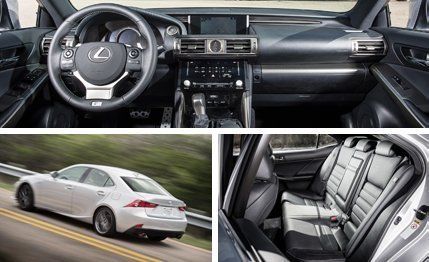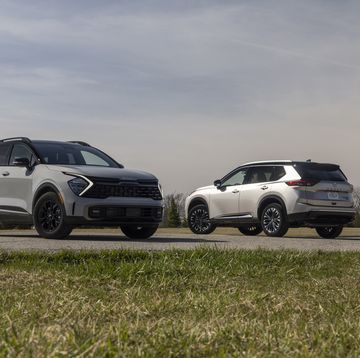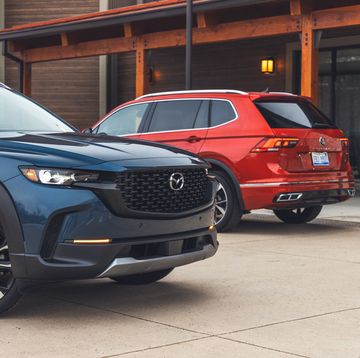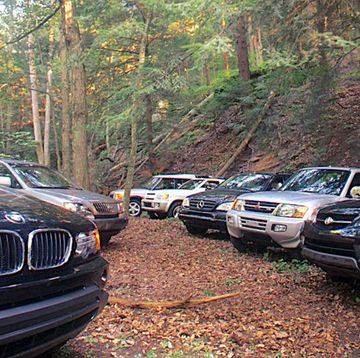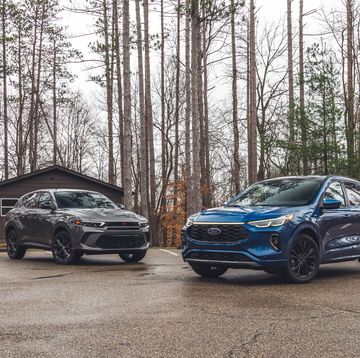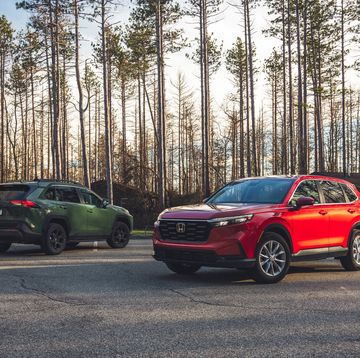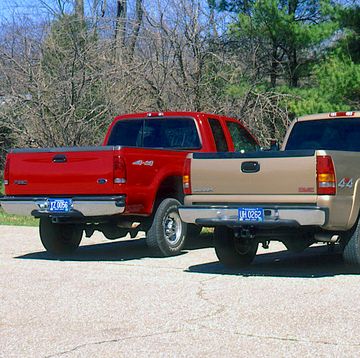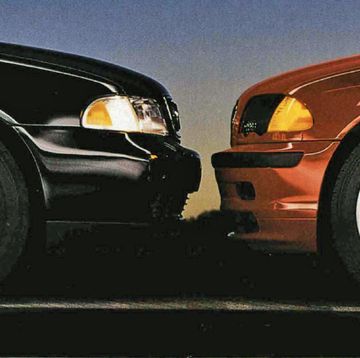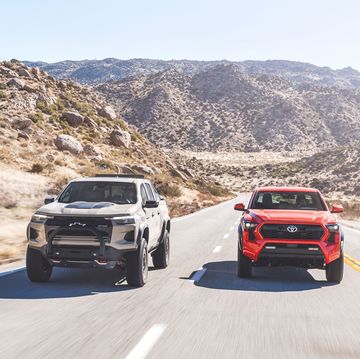From the June 2013 issue of Car and Driver.
Spiritually, we feel a little adrift. When Pope Benedict XVI resigned in February, it was the second deeply confounding blow in a short period. A few months prior, we’d pitted the new F30-generation BMW 328i against a Cadillac ATS and concluded that the Caddy was the more entertaining car. Given the 3-series’s history in our testing—22 consecutive 10Best awards and a nearly unblemished comparison-test record—this revelation was, to us, unsettling. While the 328i eked out a victory over the ATS on the merits of its powertrain and overall polish, it seemed that perhaps the time had come to convene our own College of Cardinals. From the cars gathered here, we shall anoint the spiritual leader for sports sedans everywhere.
Don’t get us wrong. BMW still builds a divine driver, and the company isn’t just stepping down. Defending its papal tiara, here is the 335i M Sport—until the arrival of the next M3, the purest expression of BMW’s values. Compared with lesser 3s, its springs and dampers are firmer, its anti-roll bars stiffer, and its body 0.4 inch closer to the road. The BMW inline-six is the staff of power in sports-sedandom, and this one makes 300 horsepower and 300 pound-feet of torque. With a price tag of $51,545, though, it won’t leave you much for the collection basket.
Should BMW falter, the Cadillac ATS leads in the running to be ordained supreme pontiff of sports sedans. In its loss to the 328i, we called the four-cylinder ATS “the best-handling sports sedan on the market today.” Its coarse turbo-four was a main culprit in that outcome; the example tested here has GM’s modern 3.6-liter V-6 with 321 horses and 275 pound-feet. Cadillac’s sport package is the FE3 performance suspension that includes GM’s magnetorheological shocks and a limited-slip differential. The ATS’s $49,185 sticker shows just how bent Cadillac is on beating BMW on a level playing field.
The emergent entry in this segment is the Lexus IS350. Architecturally a scaled-down Lexus GS, it’s 3.4 inches longer and a touch wider and taller than its predecessor. There’s a significant 2.7-inch stretch in wheelbase, and added size means added mass. The last generation’s 3.5-liter V-6 carries over with 306 horsepower and 277 pound-feet, although an eight-speed automatic helps both acceleration and fuel economy against the Lexus’s heaviest-in-test 3705 pounds. The F Sport package tweaks spring rates and damper tuning, plus it adds a more aggressive fascia and other decoration. Fresh from its debut, the IS doesn’t have an official price yet, but figure this one should go for around $49,000.
Lacking a Sistine Chapel in which to conduct our conclave, we instead headed to God’s chapel (paved by the Texas Department of Transportation) in the Hill Country north of San Antonio. There, we balloted on roads straight and flat, kinked and undulating until we came to a consensus. There was, fortunately, no puff of white smoke signalling our decision.
Third Place: Cadillac ATS 3.6
It is frustrating to put in last place a car we like as much as the ATS, doubly so to do it twice. History would suggest that Cadillac is not supposed to build cars like this, indeed, that few companies other than BMW know how. Delightfully neutral handling and hefty steering make this the most engaging car for a run through the hills; the rear end’s willingness to contribute to directional changes is both thrilling and a little nerve-racking. The Cadillac is the lightest candidate here, with a weight distribution closest to 50/50. It stopped the shortest, circled the skidpad the fastest, and beat the Bavarian in the slalom.
HIGHS: If everything were as excellent as the chassis, this would be untouchable.
LOWS: Nothing is as excellent as the chassis; CUE is as excellent as herpes.
THE VERDICT: The most fun, but the most flawed.
Even with the fancy dampers, the ATS is the only car here that doesn’t experience a dramatic personality change between its relax and attack modes. In the Lexus in particular, changing from “normal” to “sport-plus” reveals a sharp duality, but the Cadillac indulges in no such switch. With the suspension in “tour” mode, occupants feel nearly every bump in the road—but they feel them only once, and all edges are rounded off. The ATS admirably controls wheel and body motions without isolating its passengers from the sensations of speed and chassis activity. This is the car in which the driver feels the most connected.
Not only does the ATS have a unified personality, it has just one focus—its chassis. This fixation is what ruined its chances for a higher finish. The six is linear and strong through most of the range, but both power delivery and sound fray near its 7000-rpm redline. Even with the best power-to-weight ratio here, the ATS was the slowest car in the test, its six-speed trans outclassed by the opposition’s eights. Ratio count isn’t everything, but we docked the ATS points for having the slowest shifts and being the only car in which gear changes noticeably interrupt forward thrust. Against a pair of outstanding powertrains, the ATS’s was judged “merely good.”
While its compact size helps make the Cadillac feel agile and light, it also restricts interior space. Both front and rear seats were judged the least accommodating in the test, and while we like the daring red-and-black interior in our car, what looks simply low-rent on the door panels and the top of the dash feels totally unconvincing to the touch. The unappealing shifter boot appears to be stitched from wrinkly elephant hide. And our blood pressure will skyrocket if we dwell on it too much, but with every encounter, CUE—Cadillac’s touch-screen infotainment system—climbs higher on our list of unforgivable automotive sins.
Second Place: BMW 335i
Imagine how difficult it must be for the Pope to maintain his piety day in and day out, especially now that his responsibilities include posting on Twitter, forcing him to mingle with the lowest of mankind’s embarrassing low. Few can fathom that sort of unwavering discipline. BMW maintained such a regimen for years, and it has shown in the continued excellence of its cars. But after we cycled through the cars on our Hill Country loop, the question on everybody’s mind was one vocalized by technical editor K.C. Colwell: “Is it possible that the BMW has the worst steering here?” With the F30, BMW wavered. This is the first 3-series that feels less thoroughly engineered than its competition. It’s competent, it’s spacious, it’s comfortable; but in comparison with other cars in its segment, the 3-series is undercooked.
HIGHS: All hail the inline-six; may its reign be eternal.
LOWS: Noisy and busy suspension, lifeless electrically assisted steering.
THE VERDICT: Still good at everything, but no longer the best at much.
Of course, that’s a relative statement. When engaged, it is superbly balanced. Between the boosted six, which is already making peak torque at 1200 rpm, and the eight-speed automatic, its power flow is as continuous as an electric car’s. It was a full second quicker than the Caddy and Lexus to 60 mph, more than 1.5 seconds quicker to 100, and the only car to crack the 13s in the quarter-mile. Stand on the gas from a stop, and there’s a bit of lag, but with a touch of brake torque it all but disappears. In “sport” and “sport-plus” modes, the throttle response is absolutely perfect—immediate, linear, and predictable—making minute corrections simple and natural.
And yet, the M Sport package fails to rectify our complaints about the F30 chassis. There’s more movement from both front and rear axles than expected, more than its predecessor exhibited and, notably, more than either the ATS or the IS displays. Even with the optional suspension, body control falters. Bumps that the Lexus absorbs and the Cadillac shrugs off with a single succinct compression and rebound make the BMW pitch and roll and fight to stay on-line. Compared with the other two cars here, the BMW feels immense and slow-witted. Its steering also seems comparatively lazy, too light and vague on-center; and what little feel there is to begin with disappears entirely in fast transitions.
And that is what’s most damning: The M Sport is capable, but it’s not as engaging as either opponent. It seems to say to the driver, “Here, I’ll do it.” And it does, but without the grace of the Lexus or the thrill of the Cadillac. Driving should be a joint effort between machine and man, but here the driver is more along for the ride. In this grouping, it’s not the 3-series that delivers the exceptional experience.
First Place: Lexus IS350 F Sport
Habemus Papem! Like the installation of Francis, the world’s first Latin American pontiff, the crowning of a Lexus as the high priest of the sports-sedan world is something few saw coming—until we dove into the twisting, climbing, kinking, plunging roads around Leakey, Texas.
We didn’t see it coming because, on any other type of road, the IS clearly exhibits Lexus’s traditional top priority: serenity. On typical highway surfaces, minute twitches in the steering wheel and nearly imperceptible shifts of the body offer only the slightest hint of what lurks within. But charge into a series of quick bends and the IS completely changes its character. Turn-in is crisper in the Lexus than in either the BMW or the Cadillac, a fact borne out by its first-place slalom finish in spite of a mediocre skidpad performance. More important, the Lexus is utterly imperturbable. Bumps that send other cars skittering off-line or scrambling to maintain their course are absorbed and dispatched, but not kept completely hidden from the driver.
HIGHS: A most delightful split personality, heavenly seats.
LOWS: Can feel remote and lazy when insufficiently challenged.
THE VERDICT: Slumbering Lexus wakes up, woos us, and wins us over.
It used to be that, in this class, there was a clear divide in terms of refinement between the BMW inline-six and the engines offered by competitors. That gap is rapidly shrinking. Both the Cadillac’s and the Lexus’s Vs are surprisingly close to the BMW straight-six, but the IS’s is smoother than the ATS’s. And its eight-speed automatic is quicker and more seamless than the Caddy’s six-speed though basically on par with BMW’s transmission.
Additionally, the Lexus is lavishly, indulgently comfortable. Its front seats are an ergonomic feat, perfectly cupped and padded with no tangible break between back and bottom cushions, just one immaculate sweep of support from shoulders to thighs. Our drivers, trapped within a wide array of body types, unanimously swooned. Yes, the BMW is slightly more spacious in the rear, but nobody anywhere in that car is as comfortable as the people in the front of the Lexus. It’s a good thing we have so few other complaints about the IS, though, because its mouse-operated infotainment system burns through our good will in short order and turns us into sputtering, apoplectic maniacs. “Distracted driving” is a rallying cry for safety advocates everywhere; this device is infotainment’s nadir, a deserving flashpoint for a revolution against its kind.
Every other negative gets turned around when you wake the IS up, though. Its variable-ratio steering, seemingly overboosted and a touch slow in highway travel, comes alive on coursing two-lanes, quickening and taking on a pleasing heft. The brake pedal feels a tad touchy when commuting, but reacts more predictably under duress, better coordinating pressure to stopping power. The IS manages to be both typically Lexus-civil and delightfully capable (its stops are still the longest, though). Roman Catholicism preaches transubstantiation, the belief that consecrated bread and wine become flesh and blood. The manner in which the Lexus transforms from innocuous to vivid is nearly as miraculous.
| Final Results | ||||
| Vehicle | Max Pts. Available | Lexus IS350 F Sport | BMW 335i M Sport | Cadillac ATS 3.6 |
| Driver Comfort | 10 | 10 | 8 | 7 |
| Ergonomics | 10 | 8 | 10 | 7 |
| Rear-seat Comfort | 5 | 4 | 5 | 2 |
| Rear-seat Space* | 5 | 3 | 5 | 4 |
| Trunk Space* | 5 | 5 | 5 | 5 |
| Features/Amenities* | 10 | 7 | 8 | 10 |
| Fit and Finish | 10 | 10 | 8 | 8 |
| Interior Styling | 10 | 9 | 8 | 8 |
| Exterior Styling | 10 | 9 | 9 | 8 |
| Rebates/Extras* | 5 | 0 | 1 | 1 |
| As-tested Price* | 20 | 20 | 19 | 20 |
| Subtotal | 100 | 85 | 86 | 80 |
| Powertrain | ||||
| 1/4-mile Acceleration* | 20 | 17 | 20 | 16 |
| Flexibility* | 5 | 4 | 3 | 5 |
| Fuel Economy* | 10 | 8 | 10 | 8 |
| Engine NVH | 10 | 9 | 10 | 8 |
| Transmission | 10 | 10 | 10 | 7 |
| Subtotal | 55 | 48 | 53 | 44 |
| Chassis | ||||
| Performance* | 20 | 17 | 19 | 20 |
| Steering Feel | 10 | 9 | 7 | 9 |
| Brake Feel | 10 | 8 | 9 | 9 |
| Handling | 10 | 9 | 7 | 9 |
| Ride | 10 | 10 | 7 | 8 |
| Subtotal | 60 | 53 | 49 | 55 |
| Experience | ||||
| Fun to Drive | 25 | 22 | 19 | 22 |
| Grand Total | 240 | 208 | 207 | 201 |

Jared Gall started his career with Car and Driver as an unpaid intern, but has now worked here more than half of his life. He has held numerous positions within C/D's digital and print teams and has driven some 2500 cars. Employee records indicate that he is the only staffer ever to T-bone a school bus with another school bus.
